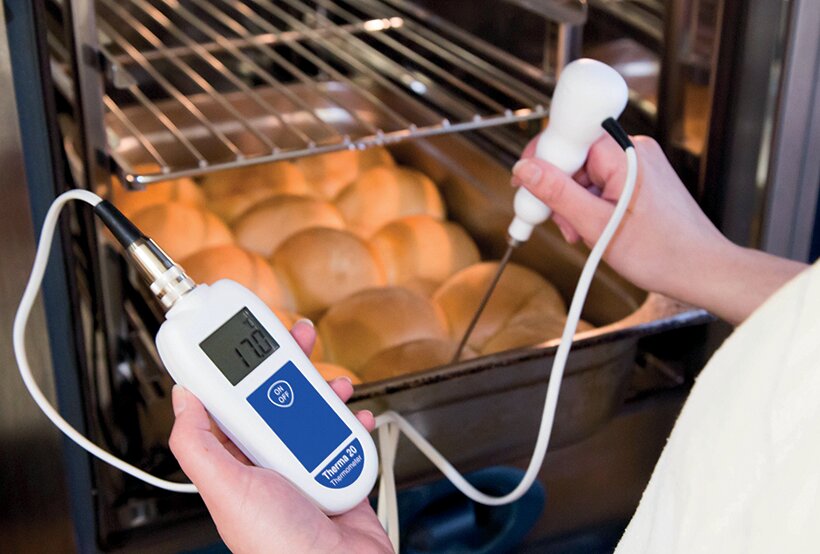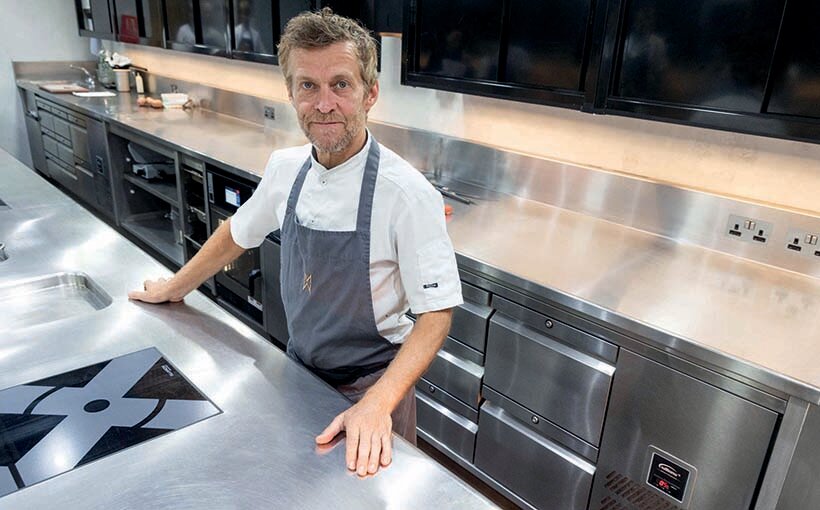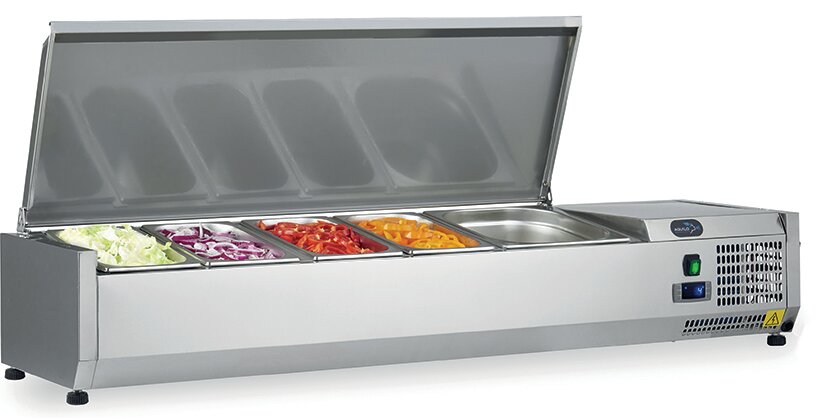Chill out with new refrigeration technology
With the latest advances in cool technology, operators can relax and let their refrigeration worry about hotspots and energy usage. Ian Boughton reports
Innovation is driving a revolution in the refrigeration sector, as food suppliers look for ways to reduce energy consumption and optimise cooling systems.
“Right now, the main desire for innovation lies in energy efficiency, because rocketing energy prices were partly responsible for the closure of almost 5,000 venues in 2022,” says Mike Nixon, sales director at Abraxas Catering Equipment.
“Refrigeration is the single largest consumer of energy in commercial kitchens; however, cooling systems also have high potential for energy savings, so we’re seeing a real swing towards energy efficient refrigeration. We’ve entered a new era – business owners are now more focused on the cost-in-use of appliances than the initial capital cost, particularly in smaller venues where the equipment is being used by the person who pays the energy bill.”
Gareth Hunt, senior product manager for Foster and Gamko, has produced an ‘energy toolkit’ to remind operators of energy saving tactics. “It’s a mix of simple, best practice energy saving advice that can make savings running into thousands of pounds a year. Simple things can seem obvious, but in the heat of a busy service are easily overlooked.”
The toolkit discusses whether counter storage has higher operating costs than upright storage and how to spot energy cost warning signs, such as appliances not getting down to optimum temperature as quickly as usual, doors not closing properly or whether condensation is caused by warm air getting into a cabinet.
Coldroom curtains can produce 20% energy savings, says the company. Adding doors to multidecks vastly reduces energy consumption, and switching from two single-door refrigerators to one double-door cabinet has been found to save 41% on energy usage.
“Our Foster EcoPro range is our best-performing, most food-safe range yet, even when shelves are fully loaded,” he says. “The Stayclear low-maintenance condenser is unlike anything else on the market, dramatically reducing blockages and the build-up of dirt, and with PureControl, staff can easily see the temperature of their refrigeration at a glance from across the kitchen.”
Caterers must pay greater attention to temperature, agrees Jason Webb, managing director at Electronic Temperature Instruments (ETI): “Inexpensive logging devices avoid the time-intensive labour of manual monitoring. Even if you think you have set the dial right, overfilling reduces the air flow and leads to hot-spots, where bacteria can flourish. Real-time temperature monitoring allows you to act immediately should any issues arise.”

Clean up your act
Several suppliers have suggested caterers’ fridge-cleaning regimes are not as efficient as they could be. Hygiene is under much stricter scrutiny following the pandemic, so manufacturers have turned their attention to innovating in that space, says Roz Scourfield, national sales manager at Hoshizaki.
“Our new Advance range features a monoblock system – a self-contained, detachable, and insulated condenser that sits on top of the unit as opposed to inside. This allows easy access for servicing, while freeing up additional storage space. It is now a matter of minutes to clean the exteriors, the fully removable shelves and surfaces.”

Liebherr’s new appliances also speed up the cleaning process, says divisional manager Tim Hutchinson. “Our new counters feature an energy efficient system whereby electronic controllers calculate the optimum defrost cycles. This reduces the defrosting time to 10 minutes, unlike other industry alternatives which take an average of 30 minutes. And food does not have to be taken out during defrosting.”
The problems of overfilling and airflow are occupying the thoughts of several suppliers. Hutchinson says: “With traditional cooling counters, if they are over-filled or badly filled, there is a chance airways can get blocked. We have designed counters with curved sides inside drawers and cabinets, leaving room for maximum airflow, even when filled to capacity.”
Airflow is a major issue, agrees Malcolm Harling, sales and marketing director at Williams Refrigeration. Williams has redesigned its airflow to make cooling as consistent as possible, with no warm spots.
Airflow applies to prep stations too – his Onyx prep stations combine refrigerated storage cabinets and a worktop with refrigerated food wells, which are cooled in two ways: the pans are cooled from beneath, while a curtain of air is blown over the top of the food, keeping warm kitchen air away. After passing over the ingredient wells, this cold air is drawn back into the Onyx, recycling the energy.
At the Angel at Hetton, North Yorkshire, chef-patron Michael Wignall is a Williams customer and says his business now probably has the most energy efficient kitchen in the country. He says, his blast chiller is probably his most important piece of equipment. “This is about cooling hot food quickly, if it is not being served right away,” says Harling. “Time management comes into play here, because you can cook food in advance, when things are quiet, then blast-chill or blast-freeze it to use later. It’s a lot less stressful than having to cook everything all at once.
“A blast chiller will get food through the temperature danger zone, in which bacteria grows quickly, as fast as possible. Traditionally, blast chillers take food from 70°C to 3°C in 90 minutes – the Williams blast chiller can handle hotter food, up to 90°C and get the job done in the same time.”
Hubbard says its Submarine blast chiller is one of a kind: “Submarine is an innovative twist on blast chiller and freezer technology that creates a multifunctional appliance,” says Hubbard marketing manager David Rees. “It can perform all the functions of standard blast chillers, but adds precise temperature control between 85°C and -40°C to create a powerful blast chiller freezer that can also cook. It can operate as a retarder or roofer for dough and other baked goods, can be used to dehydrate fruit, culture yogurt, prepare ice-cream, or as a slow cooker at temperatures up to 85°C.
“I’m unaware of any other mainstream manufacturer producing something with this functionality. I’m confident to say it’s unique.”

Power to the people
Williams says that a major new problem is electricity supply to kitchens – at the Angel, the power requirement was over double the total available to its home village. The answer was an intelligent energy management system, which scans connected equipment and diverts power to where it is needed.
The Foodservice Equipment Association recently noted that such systems reduce a kitchen’s overall energy consumption, and predicted that ‘energy modulation, via the connected kitchen, will be increasingly important’.
“As more kitchens move away from gas, they come up against insufficient electricity supply,” agrees Harling. “This is not just for the big players, it applies to the average kitchen. Energy management systems will become prevalent because they can be cheaper than a power supply upgrade. A gastropub was recently quoted £150,000 to upgrade its power supply, but installed an energy management system for £28,000.
“Energy costs are only going one way, and I think that in 10 years’ time, every new kitchen will feature an energy management system.”
Total transparency
Display refrigeration helps food stand out, because the buying decision can rest on the customer seeing the product. Gary Thacker, sales director at Fri-Jado, says: “Our Modular Convenience Counter refrigeration range is designed to offer a 360° view of your food – the units provide up to 75% more visibility than competitor models. The MCC Cold uses slim, transparent, adjustable shelves which appear to be floating.”
Aquilo Refrigeration is a new name, providing a well-specified yet affordable range of pizza fridges and prep fridges, focusing on reliability, energy saving and ease of maintenance, says managing director Sandro Wulkan. The countertop prep fridges double as back of house prep units or front of house servery items, the pizza fridges feature auto-condensation units to keep dough at the right humidity and self-closing doors to avoid anything being left ajar.
Suppliers
Abraxas abraxascatering.co.uk 01562 863 222
Adande www.adande.co.uk 01502 537135
Aquilo www.aquilorefrigeration.co.uk 0800 093 8343
ETI thermometer.co.uk 01903 202151
Foster and Gamko www.fosterrefrigerator.com 01553 691122
Fri-Jado www.frijado.com 01895 272227
Hoshizaki www.hoshizaki-europe.com 01322 616900
Liebherr home.liebherr.com 03330 147888
Scotsman/Hubbard www.scotsman-ice.co.uk 01473 350045
Williams www.williams-refrigeration.co.uk 01553 817000



















